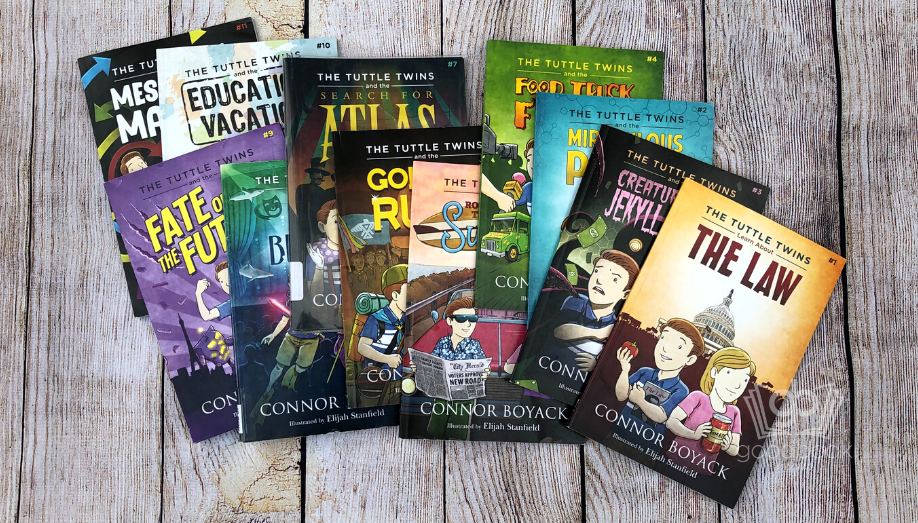
Summary
These twelve short books read like a chapter book, but do not have chapters. They are essentially a long picture book, but look and feel like a chapter book. Each book in the series highlights an idea of the principles of a free society. While they do not have to be read in succession, they do build upon each other and are best read in their designated order. (The original series release only had 11 books, which is what this review reflects.)
The Law: Talks about how the government was formed to protect our God-given rights and the government’s current role in our lives. It addresses legal plunder, our conscience, and wisdom. It is based on Frederic Bastiat’s books of the same name.
The Miraculous Pencil: Helps children understand the free market by mapping out a “family tree” of all the people involved in making a pencil. It covers spontaneous order, central planning, and division of labor. It is inspired by Leonard Read’s essay, “I, Pencil.”
Creature From Jekyll Island: Helps children understand the Federal Reserve and central banking. It addresses inflation and fiat currency.
Food Truck Fiasco: Teaches children about competition in business with an emphasis on protectionism. It also addresses business terms like capital, profit, and regulation. It is inspired by Henry Hazlitt’s book Economics in One Lesson.
Road to Surfdom: Shows the effects central planning can have whether intended or otherwise. It also addresses collectivism and eminent domain. It is based on F.A. Hayek’s book, The Road to Serfdom.
The Golden Rule: Addresses the principle that most religions and cultures agree on. It addresses blowback, collaboration, justice, and the non-aggression principle.
The Search for Atlas: Teaches the basic downfalls of socialism. Other ideas addresses are supply and demand, work ethic, incentive, and personal responsibility. This is inspired by Ayn Rand’s book, Atlas Shrugged.
Spectacular Show Business: Teaches children the realities and excitement of being an entrepreneur. It discusses budget, equity, investment, monopoly, and profit margin. It is influenced by Dr. Israel M. Kirzner’s book Competition and Entrepreneurship.
The Fate of the Future: Talks about the future and what it could possibly look like in a dystopian society where coercion is the standard. Other terms discussed are jurisdiction, government, persuasion, and polycentric law. It is inspired by Murray Rothbard’s book, Anatomy of the State.
Education Vacation: Discusses the shortcomings of traditional education and explores homeschooling as another option. The terms discussed include compulsory education, conformity, propaganda, and social engineering. It is influenced by John Taylor Gatto’s book, The Underground History of American Education.
Messed Up Market: Explores the risks of loaning money to businesses and how to choose a low-risk business in which to invest. It addresses incentive, interest, opportunity cost, subsidy, and trade-offs.
Reading Level: 5-11 years old
Read Aloud: 5+
Mom Thoughts
This very popular series from Connor Boyack addresses aspects of a free society. Boyack is a member of the LDS church (Mormonism), but there are no uniquely Mormon thoughts openly conveyed. However, it is very clear that the “good” people in the books do the “good” things. God is mentioned in a few of the books, but only briefly and in passing. These are written for an American audience.
These books are divisive, no doubt, because the foundations and principles of capitalism are no longer always upheld as positive. While targeted at children 5-11, these books are probably best for children seven and over. Because they are published by a member of the LDS church, I do not recommend that you purchase these titles as LDS businesses usually give large amount of money to the LDS church which furthers the spread of a false gospel. If you’d prefer to use them, borrow them from the library.
While there are no language or questionable behavior issues, do know that in the book The Golden Rule, two white men and a black woman dress in full Native-American clothing. Also, the book The Law points out many of the flaws in our government, but doesn’t point out many of the benefits of having a government and laws, so one could argue that it is not a balanced view.

